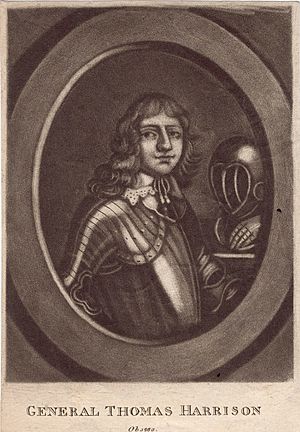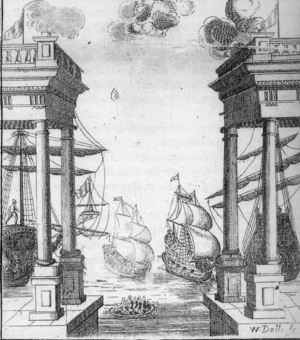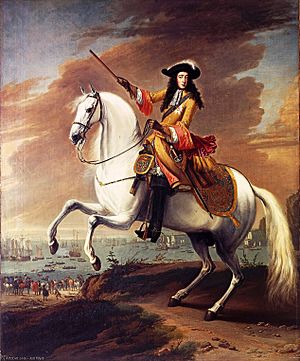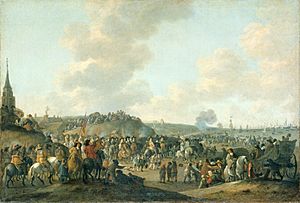Stuart Restoration facts for kids
| 1660–1714 | |

King Charles II in coronation robes by John Michael Wright
|
|
| Preceded by | Interregnum |
|---|---|
| Followed by | Georgian era |
| Monarch |
|
| Leader(s) | Thomas Parker |
The Restoration was when the Stuart monarchy returned to power in England, Scotland, and Ireland in 1660. This happened after a period of civil wars and a time when England was a republic, known as the Interregnum (1649–1660). King Charles II came back from living in other countries to become king.
The word Restoration is also used for the years that followed, when a new way of governing was set up. It often refers to the entire time Charles II was king (1660–1685). Sometimes, it even includes the short rule of his brother, King James II (1685–1688). In some cases, it covers the whole period of the later Stuart kings and queens until Queen Anne died in 1714. This was when the Hanoverian king George I took the throne. For example, Restoration comedy plays were written until about 1710.
Contents
- The Time Before: The Protectorate
- Charles II Returns to the Throne
- England and Wales: What Happened to the Rebels?
- Small Uprising: The Venner Rebellion (1661)
- The Church of England Returns
- Ireland and Scotland
- English Colonies and the Restoration
- Culture During the Restoration
- The End of the Restoration: The Glorious Revolution
The Time Before: The Protectorate
Before the Restoration, England was a republic led by Oliver Cromwell and then his son, Richard Cromwell. After Richard Cromwell stepped down in 1659, there was some confusion about who should lead.
A general named George Monck was in charge of the army in Scotland. He decided to march his army south towards London. Other military leaders who had been in charge lost their support. Monck reached London without anyone stopping him. He helped bring back members of Parliament who had been removed earlier.
Some people who had been important during the republic were arrested. One general, John Lambert, tried to start another civil war but was quickly caught. He stayed in prison for the rest of his life.
Charles II Returns to the Throne
On April 4, 1660, Charles II made a statement called the Declaration of Breda. In it, he promised certain things if he became king again. Meanwhile, General Monck helped set up a new Parliament. This Parliament met on April 25.
On May 8, this Parliament announced that Charles II had been the rightful king since his father, Charles I, was executed in 1649. It was as if the years of the republic had never happened.
Charles II came back from his exile. He left The Hague on May 23 and landed in Dover on May 25. He rode into London on May 29, 1660, which was his 30th birthday. To celebrate his return, May 29 became a public holiday called Oak Apple Day. He was crowned king on April 23, 1661.
Many people at the time saw the Restoration as a miracle. They felt it was a return to the natural order after a time of political chaos. A new Parliament, called the Cavalier Parliament, met in May 1661. It lasted for over 17 years and was mostly made up of people who supported the king.
A very important political figure at the start of the Restoration was Edward Hyde, 1st Earl of Clarendon. He was known for his wisdom in making the king's return happen smoothly. Many people who had supported the king during the civil war and had been in exile also returned. They were often given rewards like titles or land.
England and Wales: What Happened to the Rebels?

The new government passed a law called the Indemnity and Oblivion Act on August 29, 1660. This law pardoned most past acts against the crown. However, it specifically did not pardon those who had been involved in the trial and execution of Charles I.
Many of the judges who had signed the king's death warrant were still alive. They were hunted down, and some were put on trial. A few managed to escape to the American colonies.
Twelve people were sentenced to death. The first person found guilty was Thomas Harrison. He was seen as a threat to the new government. In October 1660, ten people were publicly executed in London. These included several who had signed the death warrant, a preacher, and those who commanded the guards at the king's trial.
The bodies of Oliver Cromwell, Henry Ireton, and John Bradshaw were dug up. They were then publicly displayed as a symbol of the new king's power. Later, in 1662, three more people who had signed the death warrant were brought back from Holland and executed. Many others were imprisoned for life.
Small Uprising: The Venner Rebellion (1661)
On January 6, 1661, a small group of about 50 people, led by a man named Thomas Venner, tried to take control of London. They believed that "King Jesus" should rule. Most of them were killed or captured. Venner and ten others were executed for treason a few days later.
The Church of England Returns
The Church of England was brought back as the official national church in England. New laws, like the Act of Uniformity 1662, made sure of this. People celebrated by dancing around May poles, which was a way of showing they were happy the old ways were back.
Ireland and Scotland
In Ireland, the republic was also seen as if it had never happened. Charles II called his first Irish Parliament in May 1661. Like in England, May 29 was made a public holiday. James Butler, 1st Duke of Ormonde became the main political leader in Ireland during this time.
In Scotland, Charles was declared King again on May 14, 1660. He had already been crowned in Scotland in 1651, so there was no new coronation. People in Scotland were very happy about the Restoration. Charles II called his Scottish Parliament in January 1661. This Parliament began to undo all the laws that had been forced on his father, Charles I of Scotland, since 1633.
English Colonies and the Restoration
Caribbean Colonies
Barbados had supported Charles II during the republic. When news of the king's return reached Barbados in July 1660, the island quickly declared its loyalty. Jamaica had been taken by Oliver Cromwell's forces. Charles II decided to keep Jamaica as a British colony. In 1661, it officially became a British colony, and its first governor was appointed.
North American Colonies
The colonies in New England, like Massachusetts, had generally supported the republic. They were slow to accept the Restoration. Rhode Island declared its loyalty in October 1660, and Massachusetts finally did so in August 1661. The Colony of New Haven had given shelter to some of the people who had signed Charles I's death warrant. Perhaps as a punishment, it was later joined with the Connecticut in 1662.
Virginia was very loyal to King Charles II. It had been one of the last places to give in to the republic. Virginia had also welcomed supporters of the king who were fleeing England. In 1660, the governor, William Berkeley, declared Virginia's loyalty to the king. The Anglican Church was also brought back as the official church there.
Bermuda was also very loyal. It was the first colony to recognize Charles II as king in 1649, even before he returned to England. The people of Bermuda had some disagreements with the company that ran the colony. They took their complaints to the king, who supported them. This led to the company's royal charter being taken away in 1684. After that, the king appointed Bermuda's governors.
In 1663, the Province of Carolina was created. This was a reward for some of the people who had supported the Restoration. The province was named after the king's father, Charles I. The city of Charleston was founded in 1669 by settlers from Bermuda and England.
Culture During the Restoration
The Restoration brought a big change in culture. After the strict rules of the Puritan time, there was a sudden shift towards more freedom and fun. For the first time, women were allowed to act on stage in plays. In Scotland, bishops were brought back into the church.
To celebrate and strengthen their friendship, the Dutch Republic gave Charles II a wonderful gift. It included beautiful old paintings, sculptures, furniture, and even a yacht.
Literature
Restoration literature includes writings that celebrated or reacted to the return of King Charles II's court. During this time, important works like Locke's Treatises of Government were written. The Royal Society, a famous scientific group, was also founded. News became something people bought, and essays became a popular way to write.
Style
The return of the king and his court from exile brought new styles. The serious Puritan look was replaced with a love for grand and rich designs. Dutch and French art styles became popular. This could be seen in furniture, which used new materials like walnut wood and fancy designs. Chairs had cane seats, and cabinets had beautiful carvings. Similar changes happened in writing styles.
Comedy
Restoration comedy plays were very popular. They attracted many different kinds of people, from rich nobles to middle-class families. These plays were exciting because they talked about current events. They also featured the first professional actresses and celebrity actors. This period also saw the first professional female playwright, Aphra Behn.
Spectacular Plays

The Restoration spectacular was a type of play that used amazing stage effects. These shows thrilled audiences with action, music, dance, moving scenery, and special effects. They used trapdoors, "flying" actors, and even fireworks. These plays were very popular and drew huge crowds.
These shows were sometimes called "English opera," but they were more about the amazing visuals than the music. The expensive scenery and effects were what really brought in the crowds. Putting on these elaborate shows was very costly for theatre companies. A flop could lead to big debts, while a hit could bring in a lot of money.
The End of the Restoration: The Glorious Revolution

The Glorious Revolution brought the Restoration period to an end. This event overthrew King James II of England. It happened when English Parliament members joined forces with the Dutch leader William III of Orange-Nassau. William successfully invaded England with a Dutch fleet and army. This led to him becoming king, ruling jointly with his wife, Mary II, who was James's daughter.
In April 1688, James II tried to force his religious policies on the country. He ordered all Anglican church leaders to read a special declaration to their congregations. Seven bishops, including the Archbishop of Canterbury, asked the king to rethink his policies. They were arrested and put on trial. On June 30, 1688, a group of seven important Protestant nobles invited William of Orange to come to England with an army. By September, it was clear William would invade.
When William arrived on November 5, 1688, James lost his courage. He decided not to fight the Dutch invaders and tried to escape to France. He was caught but later released. William, not wanting to make James a martyr, let him escape on December 23. James was welcomed in France by his cousin, Louis XIV.
William then called a new Parliament to decide what to do. This Parliament declared that James, by fleeing to France, had given up his throne. They said the throne was now empty. To fill it, James's daughter Mary was declared Queen. She would rule together with her husband, William, who would be King. The English Parliament then passed the Bill of Rights of 1689. This law criticized James for misusing his power.
The Bill of Rights listed James's wrongdoings. These included trying to change laws about religion and punishing the bishops for their petition. It also said that no Roman Catholic could ever become king or queen of England. Also, no English monarch could marry a Roman Catholic.


